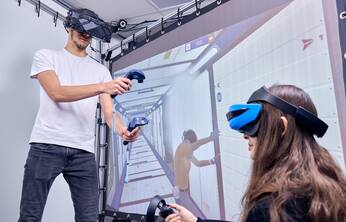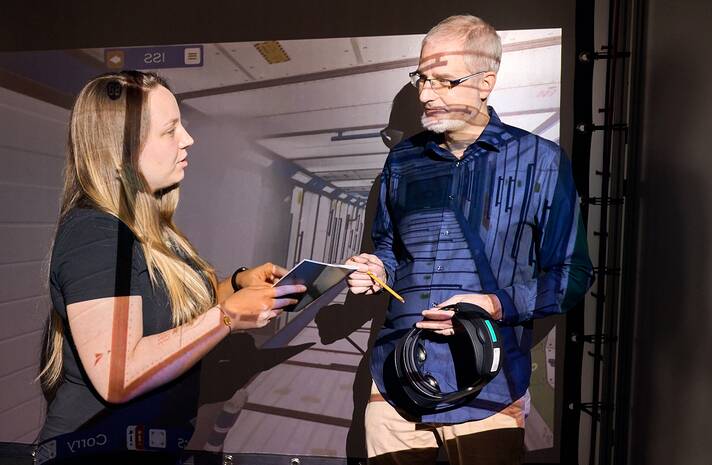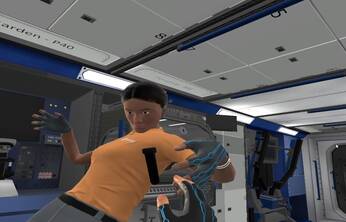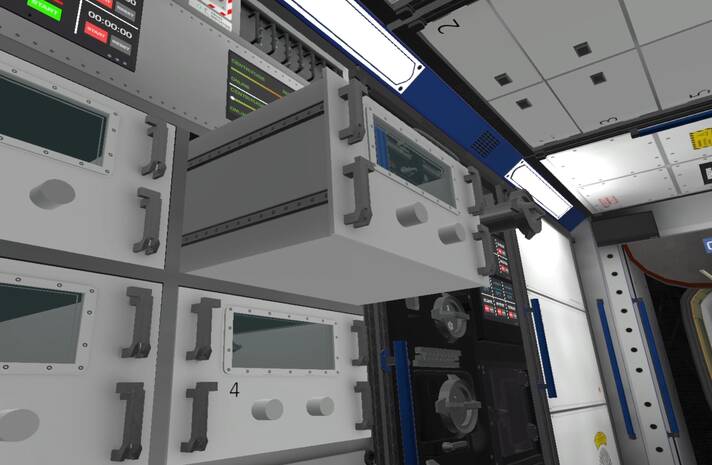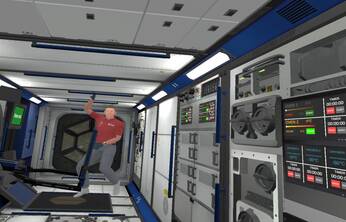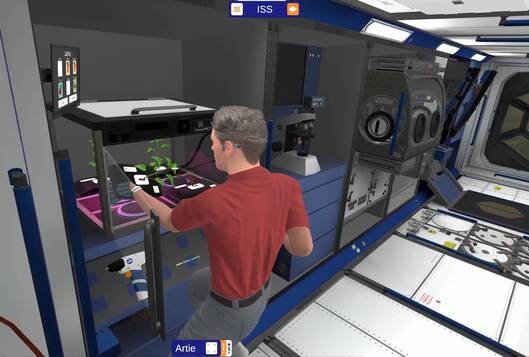The Deloitte Space Shuttle team multiplayer game lets kids experience space like never before. "After putting on the headset, they will find themselves in an environment inspired by the International Space Station ISS, where they are tasked with performing scientific experiments similar to those performed by real astronauts," says Dr. David Sedláček, head of the Virtual and Augmented Reality Laboratory at the Faculty of Electrical Engineering of CTU.
Over the course of two years, eight computer graphics students made significant contributions to the programming of the environment, taking inspiration from ISS videos to implement virtual reality tools. "Our goal was to create an authentic environment that would evoke a powerful experience of the mission to space for the participants. This includes, in particular, a simulated weightless state in which objects need to be attached with Velcro, otherwise they would float freely in the air. People also have to learn how to move in space, bounce off handrails and hold on to them, which they pick up quite quickly," says Dr Sedlacek, describing the main space difference the developers had to deal with. At the same time, he adds that they did not use all the possibilities that virtual reality offers. For example, the game doesn't allow players to turn around in the air because it would make them nauseous.
The app will be available at two high schools and Planetum
In order to offer a realistic, interactive and entertaining environment for exploring the mysteries of space, the authors combined two scenarios - in the first, educational one, the three-member crew performs research tasks and conducts scientific experiments. In the second scenario, the astronauts face the threats that can occur in space: their station is threatened by space debris, they are exposed to radiation and have to leave the ship within a limited time.
"Once the action turns into an escape game, participants in a state of emergency have to work together because some tasks cannot be solved individually. Qualities such as their mental and psychological resilience, ability to solve problems under pressure or team spirit stand out," says Jan Spratek from Planetum, who was responsible for the technical and factual side of the matter within the authoring team.
Planetum plans to use the new application for the general public in its own virtual laboratory in the near future. As part of the activities of the European Space Agency's ESA Education Office for the Czech Republic, Jan Spratek is already in contact with two secondary schools that have the necessary technological facilities and are ready to deploy the app in their teaching or use it as an element to make space topics more attractive - the Josef Bozek Gymnasium in Český Těšín and the Smíchov Secondary Industrial School and Gymnasium. Further extension of the application to secondary and primary schools is linked to the availability of their own virtual laboratories.
According to Jan Spratek, the themes of space and manned space flight are very attractive for children and can be used to build their relationship with natural and technical subjects. The space station is both a science laboratory and a place of adventure, and the virtual reality application combines both aspects into one intense experience. In the context of currently available VR applications popularizing space and astronomy, Jan Spratek considers the new application from FEE CTU and Deloitte to be unique not only in the Czech Republic, but also globally.
Under the pressure of emotion, the character is revealed
The application allows you to play not only in virtual reality, but also to view the virtual world on your computer in the observer mode. These are also available for when players need advice; observers can help from the outside, but also judge how players communicated with each other, whether they were acting as a team or more on their own.
"What is valuable for the observer is that after about five to ten minutes, the participants start to behave very authentically. They are immersed in an environment that is completely new to them and they don't know how to behave and what will bring them plus points. We were surprised by the emotions that the game can evoke in them," explains Jakub Hrdina, Immersive Technology Manager at Deloitte.
Jakub Hrdina was at the birth of the whole project, originally intended for internal purposes, for example for recruitment or as a diversion for occasions such as teambuilding. The consulting and technology company Deloitte sees a deeper potential in the project it funded and further profiles it as a mentoring and human resources development service that will find use on the client side. Jakub Hrdina is convinced that innovative virtual or augmented reality technologies that develop individuals and teams in a gamified, fun way will soon find wider application. For these reasons too, the space escape game will be available in an English version for an international audience.
Creative team - script, requirements:
Jan Spratek (Planetum - Prague Observatory and Planetarium)
Jakub Hrdina (Deloitte)
Miky Skoda ( https://www.mikyskoda.cz/ )
for FEE CTU:
Uršula Žákovská, Dr. David Sedláček, Lukáš Pospíšil, Jan Tošner, Jan Hamet, Jozef Skála, Markéta Machová, Barbora Koudelková, Josef Bacík (students and graduates of the Open Informatics and Software Engineering and Technology programs).
Illustrative photos can be found here. Source Petr Neugebauer, FEE CTU


